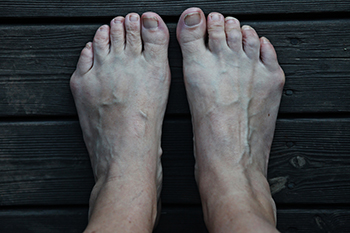Items filtered by date: May 2024
Foot Injuries at Fitness Facilities

Foot injuries are a common occurrence in fitness facilities, often the result of crush injuries from free weights, falls, or awkward landings during exercise classes. These injuries can range from minor sprains to more severe fractures, impacting one's ability to maintain an active lifestyle. Prevention techniques play a critical role in reducing the risk of foot injuries. Properly warming up and stretching before exercise sessions can enhance flexibility and prevent strains. Wearing appropriate footwear with adequate support and cushioning is essential to absorb shock and protect the feet from impact. Additionally, maintaining good form and technique during exercises can help minimize the risk of falls and accidents. If you have sustained a foot injury while working out at a fitness center, it is suggested that you schedule an appointment with a podiatrist for an evaluation and treatment. This will help with a speedy recovery and encourage you to return safely to your fitness routine.
Ankle and foot injuries are common among athletes and in many sports. They can be caused by several problems and may be potentially serious. If you are feeling pain or think you were injured in a sporting event or when exercising, consult with Elliot T. Udell, DPM from New York. Our doctor will assess your condition and provide you with quality foot and ankle treatment.
Common Injuries
The most common injuries that occur in sporting activities include:
- Achilles Tendonitis
- Achilles Tendon Rupture
- Ankle Sprains
- Broken Foot
- Plantar Fasciitis
- Stress Fractures
- Turf Toe
Symptoms
Symptoms vary depending upon the injury and in some cases, there may be no symptoms at all. However, in most cases, some form of symptom is experienced. Pain, aching, burning, bruising, tenderness, tightness or stiffness, sensation loss, difficulty moving, and swelling are the most common symptoms.
Treatment
Just as symptoms vary depending upon the injury, so do treatment options. A common treatment method is known as the RICE method. This method involves rest, applying ice, compression and elevating the afflicted foot or ankle. If the injury appears to be more serious, surgery might be required, such as arthroscopic or reconstructive surgery. Lastly, rehabilitation or therapy might be needed to gain full functionality in the afflicted area. Any discomfort experienced by an athlete must be evaluated by a licensed, reputable medical professional.
If you have any questions, please feel free to contact our office located in Hicksville, NY . We offer the newest diagnostic and treatment technologies for all your foot care needs.
How Podiatrists Help With Diabetic Foot Care
 Podiatrists play a key role when it comes to managing and preventing foot-related complications in diabetes patients. Foot issues are a common occurrence in diabetics, due to the poor blood circulation and nerve damage, or neuropathy, that often accompany the disease. Podiatrists specialize in early detection and treatment of potential foot problems like ulcers, infections, and structural issues. This makes regular check-ups with podiatrists important for someone who is at risk for these issues. During visits, a podiatrist will conduct comprehensive foot exams to look for signs of decreased circulation, changes in foot structure, or nerve damage. This foot doctor can provide guidance on proper foot care practices, such as how to safely trim nails and avoid injuries. Podiatrists may also recommend appropriate footwear to prevent pressure sores and injuries. Additionally, podiatrists can treat any current foot problems to prevent them from escalating into more serious conditions that could lead to amputation. By closely monitoring the health of a diabetic's feet, podiatrists help maintain mobility and prevent life-threatening complications. If you are at risk for foot complications due to diabetes, it is suggested that you add a podiatrist to your regular care team.
Podiatrists play a key role when it comes to managing and preventing foot-related complications in diabetes patients. Foot issues are a common occurrence in diabetics, due to the poor blood circulation and nerve damage, or neuropathy, that often accompany the disease. Podiatrists specialize in early detection and treatment of potential foot problems like ulcers, infections, and structural issues. This makes regular check-ups with podiatrists important for someone who is at risk for these issues. During visits, a podiatrist will conduct comprehensive foot exams to look for signs of decreased circulation, changes in foot structure, or nerve damage. This foot doctor can provide guidance on proper foot care practices, such as how to safely trim nails and avoid injuries. Podiatrists may also recommend appropriate footwear to prevent pressure sores and injuries. Additionally, podiatrists can treat any current foot problems to prevent them from escalating into more serious conditions that could lead to amputation. By closely monitoring the health of a diabetic's feet, podiatrists help maintain mobility and prevent life-threatening complications. If you are at risk for foot complications due to diabetes, it is suggested that you add a podiatrist to your regular care team.
Diabetic foot care is important in preventing foot ailments such as ulcers. If you are suffering from diabetes or have any other concerns about your feet, contact Elliot T. Udell, DPM from New York. Our doctor can provide the care you need to keep you pain-free and on your feet.
Diabetic Foot Care
Diabetes affects millions of people every year. The condition can damage blood vessels in many parts of the body, especially the feet. Because of this, taking care of your feet is essential if you have diabetes, and having a podiatrist help monitor your foot health is highly recommended.
The Importance of Caring for Your Feet
- Routinely inspect your feet for bruises or sores.
- Wear socks that fit your feet comfortably.
- Wear comfortable shoes that provide adequate support.
Patients with diabetes should have their doctor monitor their blood levels, as blood sugar levels play such a huge role in diabetic care. Monitoring these levels on a regular basis is highly advised.
It is always best to inform your healthcare professional of any concerns you may have regarding your feet, especially for diabetic patients. Early treatment and routine foot examinations are keys to maintaining proper health, especially because severe complications can arise if proper treatment is not applied.
If you have any questions please feel free to contact our office located in Hicksville, NY . We offer the newest diagnostic and treatment technologies for all your foot and ankle needs.
A Guide to Diagnosing Gout

Gout, a form of inflammatory arthritis, can be excruciating, often affecting the big toe and ankles. Recognizing its symptoms is vital for timely management. The diagnosis begins with a keen observation of the symptoms, which are often sudden, intense joint pain, swelling, redness, and warmth, typically striking at night or in the early hours. The affected joint might feel tender to the touch, making even the lightest pressure unbearable. An accurate diagnosis often involves a comprehensive medical history review and a physical examination by a podiatrist. They may also conduct tests like joint fluid analysis to detect urate crystals, which are consistent with gout. Blood tests measuring uric acid levels can aid in confirmation, although high levels do not always guarantee a diagnosis. Imaging tests, such as X-rays, may reveal joint damage in chronic cases. If you have pain in the top of your foot, with a focus on the big toe, it is strongly suggested that you contact a podiatrist who can effectively treat gout.
Gout is a foot condition that requires certain treatment and care. If you are seeking treatment, contact Elliot T. Udell, DPM from New York. Our doctor will treat your foot and ankle needs.
What Is Gout?
Gout is a type of arthritis caused by a buildup of uric acid in the bloodstream. It often develops in the foot, especially the big toe area, although it can manifest in other parts of the body as well. Gout can make walking and standing very painful and is especially common in diabetics and the obese.
People typically get gout because of a poor diet. Genetic predisposition is also a factor. The children of parents who have had gout frequently have a chance of developing it themselves.
Gout can easily be identified by redness and inflammation of the big toe and the surrounding areas of the foot. Other symptoms include extreme fatigue, joint pain, and running high fevers. Sometimes corticosteroid drugs can be prescribed to treat gout, but the best way to combat this disease is to get more exercise and eat a better diet.
If you have any questions please feel free to contact our office located in Hicksville, NY . We offer the newest diagnostic and treatment technologies for all your foot and ankle needs.
Definition and Causes of Bunionettes

Bunionettes, also known as tailor's bunions, are bony bumps that develop on the outside of the foot, near the base of the pinky toe. Understanding the definition and underlying causes of these foot deformities is vital for effective management and prevention. Essentially, a bunionette forms when the bone at the base of the fifth toe protrudes outward, often accompanied by the misalignment of the toe joint. This condition is primarily attributed to structural imbalances in the foot, including inherited foot shapes, abnormal foot mechanics, or wearing narrow shoes that compress the toes. Over time, pressure and friction on the affected area can exacerbate the deformity, leading to pain, inflammation, and difficulty wearing certain footwear. While bunions and bunionettes share similar characteristics, they affect different areas of the foot. Bunionettes typically develop on the outer edge of the foot, whereas bunions occur at the base of the big toe. If you have developed a bunion or bunionette, it is suggested that you visit a podiatrist who can determine what the best course of treatment is for you.
If you are suffering from bunions, contact Elliot T. Udell, DPM of New York. Our doctor can provide the care you need to keep you pain-free and on your feet.
What Is a Bunion?
A bunion is formed of swollen tissue or an enlargement of boney growth, usually located at the base joint of the toe that connects to the foot. The swelling occurs due to the bones in the big toe shifting inward, which impacts the other toes of the foot. This causes the area around the base of the big toe to become inflamed and painful.
Why Do Bunions Form?
Genetics – Susceptibility to bunions are often hereditary
Stress on the feet – Poorly fitted and uncomfortable footwear that places stress on feet, such as heels, can worsen existing bunions
How Are Bunions Diagnosed?
Doctors often perform two tests – blood tests and x-rays – when trying to diagnose bunions, especially in the early stages of development. Blood tests help determine if the foot pain is being caused by something else, such as arthritis, while x-rays provide a clear picture of your bone structure to your doctor.
How Are Bunions Treated?
- Refrain from wearing heels or similar shoes that cause discomfort
- Select wider shoes that can provide more comfort and reduce pain
- Anti-inflammatory and pain management drugs
- Orthotics or foot inserts
- Surgery
If you have any questions, please feel free to contact our office located in Hicksville, NY . We offer the newest diagnostic and treatment technologies for all your foot care needs.


